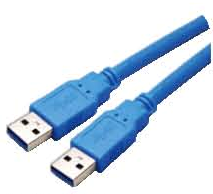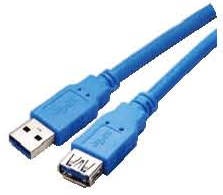
 Lan Cable
(29)
Lan Cable
(29)
 Patch Cord
(25)
Patch Cord
(25)
 Optic Fiber
(74)
Optic Fiber
(74)
 Networking Accessories
(424)
Networking Accessories
(424)
 Cable Management
(16)
Cable Management
(16)
 Networking Tools
(206)
Networking Tools
(206)
 Computer Cable
(434)
Computer Cable
(434)
 HDMI Cable
(424)
HDMI Cable
(424)
 USB Cable
(49)
USB Cable
(49)
 Computer Connector
(50)
Computer Connector
(50)
 Coaxial Cable
(1)
Coaxial Cable
(1)
 Alarm Cable
(30)
Alarm Cable
(30)
 Speaker Wire
(8)
Speaker Wire
(8)
 CCTV Accessories
(24)
CCTV Accessories
(24)
 Iphone Cable
(15)
Iphone Cable
(15)
 Computer Peripherals
(78)
Computer Peripherals
(78)
 New Products
(43)
New Products
(43)
USB 3.0 SERIES
Recently released and just starting to show up on computers and devices is USB 3.0. USB 3.0 is faster than USB 2.0, and fully backwards compatible. Keep in mind that the physical USB type B and micro B connectors on USB 3.0 cables are different than on USB 2.0 cables.
USB 3.0 is the second major revision of the Universal Serial Bus (USB) standard for computer connectivity. The standard from 2008 implements a 5 Gbit/s transfer rate. In the late 1990s, the first major revision was made to the USB 1.1 specification. The revision was called USB 2.0 which added a new transfer speed called Hi-Speed (HS – 480 Mbit/s) to the earlier speeds (Low Speed (LS) – 1.5 Mbit/s and Full Speed (FS) – 12 Mbit/s).

USB 3.0 A male to A male USB 3.0 A male to B male

USB 3.0 A male to A female USB 3.0 A male to micro B male
Implementation differences compared to USB 2.0
The USB 3.0 specification is similar to USB 2.0 but with many improvements and an alternate implementation. Earlier USB concepts like endpoints and four transfer types (bulk, control, isochronous and interrupt) are preserved but the protocol and electrical interface are different. The specification defines a physically separate channel to carry USB 3.0 traffic. The changes in this specification make improvements in the following areas:
USB 3.0 has transmission speeds of up to 5 Gbit/s, which is 10 times faster than USB 2.0 (480 Mbit/s).
USB 3.0 vs USB 2.0 Feature Comparison:
|
Features |
USB3.0 |
USB2.0 |
|
Data Rate |
SuperSpeed (5.0Gbps) additional |
low-Speed (1.5Mbps) |
|
Data Signal |
SS OUT Differential Signal:1 Pair |
Differential Signal:1 Pair |
|
Connector Signals |
4 wires: SuperSpeed |
2 wires: DP/DM for USB 2.0 |
|
Bus Protocol |
No polling |
Uses polling |
|
Power Control |
Configuration at multiple link levels |
Suspend/Resume by Port |
|
Power Supply to Bus |
Max. 900 mA |
Max. 500 mA |
USB 3.0 vs USB 2.0 Speed Comparison:
USB 3.0 vs USB 2.0 Specification Comparison:
Architecture and features
In USB 3.0 dual-bus architecture is used to allow both USB 2.0 (HIGH Speed/LOW Speed/FULL Speed) and USB 3.0 (Super Speed) operations to take place simultaneously, thus providing backward compatibility. Connections are such that they also permit forward compatibility, that is, running USB 3.0 devices on USB 2.0 ports. The structural topology is the same, consisting of a tiered star topology with a root hub at level 0 and hubs at lower levels to provide bus connectivity to devices.
Specification:
1.cable: 28AWG,24AWG,22AWG,20AWG




2.Jacket color: Black, Blue, White, Transparent or your requirement..
3. Nickel-plated and Gold-plated connector
4. Length: 0.5m,1m,1.8m,3m,5m are available.
What is a USB adapter?
One of the most prevalent connection ports on today’s computers and peripheral devices is Universal Serial Bus(USB),and you can recognize a USB port or cable by its distinctive rectangular male or female end. The current of USB is 2.0;previous version are not compatible. If your desktop or laptop is a fairly new Macintosh, then you will have USB ports. Older Macs probably have something different, Windows machines switched to USB ports earlier than Macs, but some older PCs still have non-USB ports.
One of the most common non-USB ports is the serial port. This kind of cable-port combination routinely has pins of varying numbers on cables that fit in corresponding numbers of holes in ports. Even some of the most recently manufactured computers have serial ports for connecting peripherals like printers and scanners.
A problem can arise if you buy a newer computer and want to connect it to an older printer. The computer likely has a USB port. but the printer probably has a serial port. This can be the case with newer computers as well. In order to connect the two devices, you need a USB adapter.
The USB adapter connects USB-port devices to non-USB-port devices. A USB adapter usually has a USB cable on one end and a non-USB cable on the other end. Just plug the correct end into the correct port, and you can overcome what would seem to be an insurmountable problem. The USB adapter solves that problem for you.
Another common kind of USB adapter these days is one that connects an iPod or other MP3 player to its power charger. A portable music player will likely have not a USB port, but rather some kind of serial port.This is where the USB adapter comes in handy. The cable that comes with the music player will have the serial cable on end and a USB cable on the other end. The charger device that connects to an electrical outlet will have a USB port , into which you can plug the charging cable in order to juice up the music player. In this case,the charging device itself is the USB adapter.
You can also find a USB adapter that works with wireless devices. A keyboard, mouse, or headset can be connected to your computer using a dongle that plugs into a USB port on the computer but doesn’t need to connect to anything on the other side. This might not sound like the same sort of USB adapter as the ones the ones described above, but it is a USB adapter in that it connects a USB port with a non-USB-port device.
Why do you choose us?
1. Supply the cable packing in accordance with your requirements
2. Professional design team and QC team ensure quick OEM cable order.
3. High quality and best price promise profitable products and long relationship.
4. we have ROHS compliant.
5. All of our products are high tech , they are environmental
6. Customized designs are acceptable, small order are accepted .
Feedback:
If you have any problems with the outcome of the transaction or product, please contact with us.We will reply and find solution within 24hours (except holiday) .we are also can offer you the best quality,competitive price and timely delivery. we are not best. But we will try to be better.